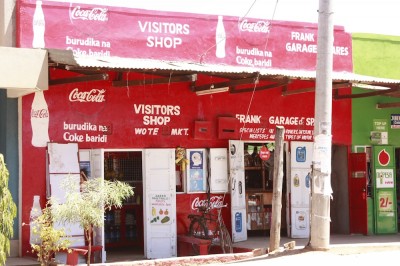Message from Africa: We Have Money. We Will Buy.
This is the first of a four-part series on Africa, The Present Frontier.
The usual picture of Africa rarely includes middle class consumers and designer brands. In fact, it rarely portrays the other reality, the true potential that lies on the continent and in its people. Sadly, this robs many western brands off the opportunity to grow their businesses by establishing a presence on the continent. There’s a fast emerging middle class in Africa that has money and aspirations. Are there enough businesses supplying hope and the stuff they dream about?
In April 2011, the African Development Bank released a report on Africa’s Middle Class that showed the floating middle class has grown to over 20% of the population. This segment between the poor and the established middle class, is the only part of the economic pyramid that has had significant growth over the last 20 years achieving 100% growth in the last 30 years. They maybe susceptible to shocks that easily push them back into poverty but unlike their counterparts living in abject poverty, they have money to spend. With a population of 1 billion people, approximately 700million of whom have mobile devices, I can easily suppose a significant number of the floating class are connected. In itself, that is only important to telcos. However, it points to a growing trend everywhere else. An increasingly larger number of people with money to spend on connectivity (for whatever reason) signals a growing appetite for technology and services that connects people. It also signals a narrowing of the digital divide. Among many other signals emmanating from Africa, these two bode well for tech enterprise in Africa. Africa is attractive.
A number of brands in both tech and non-tech sectors have seen the signals from the continent and jumped on the opportunity to achieve phenomenal growth. Here are 7.
- Syngenta recently announced it’s intention to grow its Africa business to $1billion. The firm will invest $500million and grow its workforce by 700 over the next 10 years.
- Diageo has invested $1.5billion in Africa over the last 5 years. Their Kenyan unit, maker of the iconic Tusker beer brand, EABL was one of the first listed firms to breach the $1billion market capitalization milestone.
- Unilever currently earns over $3.5billion a year from its African operations and is working to double that within the next 5 years. A big part of their focus appears to be a push deeper into rural areas where a good number of the floating and middle income population live.
- Visa acquired South African payments firm Fundamo for $110million as part of their strategy to grow their business on the continent. Despite the apparent threat their business faces from mobile payments, Visa sees great potential on the continent and executives contend that mobile payments won’t put them out of business. The acquisition of Fundamo signals their intent to never let mobile out of their sight.
- Samsung grew revenues in Africa to $1.2billion by 2010 and began a push to grow this to $10billion by 2015 with investments of $140million on the continent. Africa is the fastest growing market for mobile phone market in the world.
- Designer cosmetics maker L’Oreal expects Africa’s middle class to double over the next 10 years. It aims to grow its market 10%-20% year on year until it attains a 16% market share in Africa.
- Nokia was until recently the world’s largest mobile phone vendor. It’s number 1 position is now held by Samsung. However, five years ago, Nokia’s sales in Africa were estimated at $7billion (according to Wikinvest). It’s ability to churn out devices that struck a chord with African consumers was legendary and is still one of the continent’s most recognizable brands.

CocaCola branded shop in Kenya's Makueni District. CocaCola is the most successful beverages and FMCG business in sub-Sahara Africa.
Macroeconomic signals emanating from the continent have of course played a big role in attracting foreign investment. GDP growth in African countries touches double digits in some countries, growth rate unlikely to be witnessed in developed economies where economic growth has stagnated for some and shrunk in others (hello Greece!). Driven by agriculture, tourism, minerals and financial services, economies on the continent have outperformed those in the west even during the worst of the recent financial crisis. Sub-sahara Africa in particular has seemed insulated from the chaos in financial markets in the rest of the world. Africa is growing.
Whilst the usual story about Africa has attracted non-profits and social entrepreneurs to the continent, the story of consumer aspirations, economic growth, political stability and an increasingly educated and savvy population has attracted their for-profit counterparts. Some of the social enterprises that have setup shop here have had great success whilst others have come to Africa to die. A good indicator of whether a social enterprise will succeed on the continent is sometimes determined by how effectively it communicates hope to its market. When marketing and communications departments use the same tone for fundraising in the west to sell merchandise in Africa, one can expect dismal results because the tone in the fundraising message is one of hopelessness and desperation.
For-profit enterprises have not had to struggle with this dual-message strategy. Their message is usually ‘Buy my great stuff’ or ‘My stuff will make you great’. Even when they deliver very little hope, it goes a longer way than low prices. Some big brands have learned this the hard way. Expecting to acquire huge market share by adopting a low-margin high-volume business model that was successful in India, Airtel was handed a rude shock by the continent and has had to go back to the drawing board.
As some have suggested, hope can make a big difference to those living in economic hardship sometimes resulting in higher spending. Africa has great aspirations. Some brands have known this all along and have been handsomely rewarded by customers in Africa. Here are two brands that have always had great success with the BoP customer in Africa.
- Safaricom is East Africa’s largest mobile phone company with the world’s most notable mobile money platform, MPesa. Here’s an ad campaign they have been running recently in Kenyan media. Even with the most expensive on-net calls Safaricom remains by far the largest network by subscriber numbers and revenue.
- Coca Cola has been very successful in Africa. Present in 56 countries and territories on the continent and with over 160 bottling plants this soft drinks maker has a distribution channel that is the envy of many in the fast moving consumer goods industry. In places where there is no medication, education or even healthcare, you may still find a Coke. Their advertising seeks to inspire and the results speak for themselves. Here’s an ad currently running on African television as part of their 1 Billion Reasons to Believe in Africa campaign.
Fast growing economies, a fast growing middle class, political stability and a growing ICT sector are current features of Africa that make it a great place to be for those seeking to expand. It is also increasingly attractive for technology businesses that understand the African customer or are willing to take the time to do so. Some of the top performing brands in Africa today understand this and have been on the continent for a long time. While everyone else was talking about Africa being the next frontier they saw Africa as the present frontier. It’s still early enough for businesses to establish a presence with new products and services that have not existed on the continent. Like Wonga launching it’s first international location in South Africa.
Africa is here. The message from Africa to the rest of the world is simple.
Have money. Will buy. Who’s selling?
Related posts:
